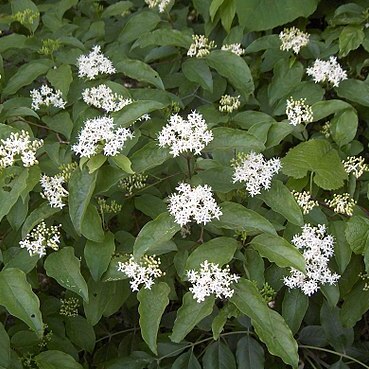Shrubs or trees, to 6 m, flowering at 1.5 m; rhizomes present. Stems solitary, 1–6 dm apart; bark pinkish gray, appearing braided, becoming corky, checkered with square or rectangular plates 2–5 mm wide; branchlets yellow-green abaxially, pink-maroon adaxially, densely erect-hairy when young; lenticels inconspicuous on new growth, protruding and splitting longitudinally on 2d year branches; pith brown, white, or tan. Leaves: petiole 8–25 mm; blade lanceolate to ovate, 2–12 × 1.2–7.7 cm, base cuneate, truncate, or cordate, apex abruptly acuminate, abaxial surface pale green, hairs curved upward, dense, adaxial surface gray-green, hairs curved upward or appressed; secondary veins 3–4(–5) per side, most arising from proximal 1/2. Inflorescences flat-topped or convex, 3–8 cm diam., peduncle 20–40 mm; branches and pedicels pink or red, fading yellow when dried, central part of pedicels white after fruit falls. Flowers: hypanthium densely appressed-hairy; sepals 0.4–1.3 mm; petals white, 2.3–3.2 mm. Drupes white, globose or subglobose, 4–7.5 mm diam.; stone subglobose, 3–6 mm diam., smooth or slightly grooved, apex rounded. 2n = 22.
More
Shrubs or occasionally small trees to 6 m; twigs scabrous, olive to pinkish-brown, with white or tan pith; old bark gray, sometimes fissuring; lvs lance-ovate to elliptic or broadly ovate, mostly 5–8 cm, commonly abruptly acuminate, broadly cuneate to subcordate at base, scabrous-strigose above and evidently rough to the touch, minutely papillose-whitened beneath and with appressed or spreading hairs often 0.5 mm; lateral veins 3 or 4(5) on a side, tending to arise from the lower half of the blade; infl flat or convex; fr white (light blue), 4–8 mm, on red pedicels; 2n=22. Wet woods and streambanks; O. and s. Mich. to s. Wis., Io., and Neb., s. to Ga. and Tex. May, June. (C. priceae)
Forming thickets along roadsides, limestone barrens, limestone outcrops, dry woodlands, rocky stream banks, prairies, old fields, meadows, swamp margins; at elevations up to 1,500 metres.


